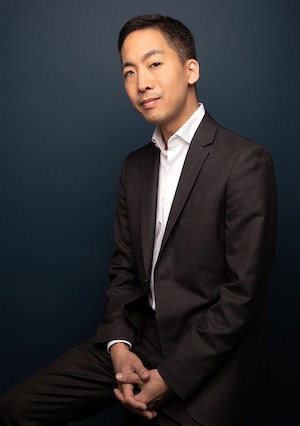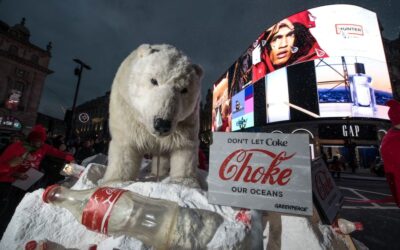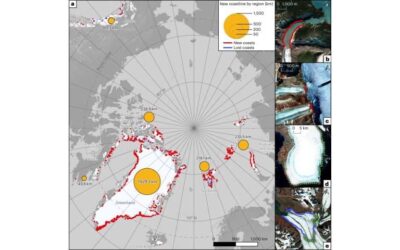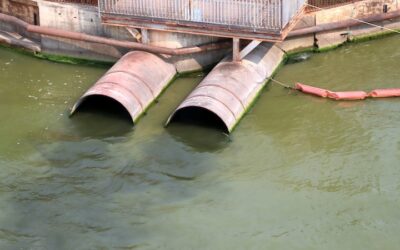This post was originally published on Eco Watch
Eddie Ahn has been an environmental justice attorney for more than 15 years. In his work as the executive director of Brightline Defense, he and his group have ensured that the offshore wind, building decarbonization and increase in electric vehicles happening in California will benefit underserved and low-income communities in the region. In recognition of his efforts, he was inducted into the California Energy Commission’s Clean Energy Hall of Fame in 2021, and had a tree planted in his honor in Sacramento.
Eddie Ahn’s author photo
More recently, Ahn became a published author. His graphic novel Advocate: A Graphic Memoir of Family, Community, and the Fight for Environmental Justice tells many stories, including that of his family’s liquor store business in Texas, his journey away from that future and into the world of nonprofits, and even a detour into his time as a poker player. But much of the text focuses on his environmental justice work. “I’m trying to explain nonprofit work and even what it means to work against something as catastrophic as climate change,” Ahn told EcoWatch.

An excerpt from Eddie Ahn’s new graphic novel
Are you trying to demystify what nonprofit work is? And what might you say are some of the more unrecognized aspects of environmental justice and climate work?
I did want to use the medium itself as a storytelling vehicle to explain this career. You know, the nonprofit world is very hard work. It can be a lot of repetition. It can be a lot of menial tasks. But I’d like to think in trying to do all those aspects of work, that one becomes intimately connected to the notion of labor, what it means to serve communities.
A lot of what I do at Brightline is extremely lean. I think one theme in the book is essentially my cheerfulness around work, being willing to do it all and then of course, recognizing there are limits to that, too, that one person can only do so much as well. And there’s a larger reflection in the book about not needing to be superhuman as well.
How rewarding is your nonprofit work for you?
I hope the reader gets a sense that even the joy of discovering different communities, of getting to learn different stories, different perspectives, it’s not common in a lot of other jobs. I’ve been able to, for instance, talk with Doctor Espanola Jackson, the community leader who’s represented in the book, who worked in Bayview – Hunter’s Point for a very long time, and that she was generous, you know, to spend time with me.
She took me under her wing and then essentially shared a lot of stories in her own experiences. She was extremely generous with her time, in other words. And, yeah, I don’t think that happens in a lot of other occupations. That is the joy – to be able to meet different community members and then, be a part of their lives in ways that one would normally would not be able to be.
Would you tell us how important locality and community is to you, and how that’s reflected in the book?
One thing I really wanted to heavily represent in the book is a sense of place, and that’s why I think comics was a unique medium to try to explore environmental justice. A lot of maps are featured in the book that give the reader a sense of, where are we? The expanse of the Bay area, public transit systems, those are all aspects I wanted to literally draw out and so that the reader can be a part of it. There’s a certain kind of Tolkienesque joy you get from it, too. That’s where we’ve been and this is where we’re going, that sense of a journey as well.
There’s a phrase in the book – “I believe in empowered communities, sustainable environments.” Can you elaborate on what you mean by that?
I’ve always tried to avoid getting into a rut of feeling like I have to fix everything or solve everything. I think of the broader arc of what needs to be done to even address climate change.
It does require a lot of communities working in collaboration with each other and essentially getting on the same page to address something as widespread and catastrophic as the climate change that events that are happening now. To empower communities really comes from a sense of giving communities the tools they need to try to address environmental issues and equity issues for themselves.
The sustainable environments portion was really trying to look at aspects of those solutions and then figuring out, okay, is this really a sustainable solution? I’ll give you an example. One subject matter we work on a lot is offshore wind. This is about wind turbines that are being proposed, off the coasts of the United States, but potentially on the Gulf and Great Lakes. The hope is that it’s not just building technology for technology’s sake. Are we connecting these turbines to the right kind of grids? Are we making sure that the hundreds of millions of dollars that are going to flow through these projects, can local communities even share in those benefits, whether it’s jobs or community benefits? Part of it is trying to look at it with that equity lens at the end of the day, and then pushing the envelope around, how can we do better?
Going back to the empowered community’s piece, we should always be trying to understand what local communities want and then honoring that to some degree. Trying to understand, here are the gaps that exist in local communities, and here are the needs that can be addressed, the introduction of this new technology. I do think there’s a broader issue in the environmental movement of feeling disconnected from the solutions that are being proposed.
You’ve worked on three different regional commissions in the San Francisco area. In the book, you mention how hard it is to make decisions, even in the context of climate change, on these commissions. How so?
One of the things I’ve had to learn as a commissioner is to consume lots of information. Particularly around something like transportation, where the policy pieces are very complex. The gist is you can get lost in the sea of information. I think if there’s one good thing out of my legal training that I can talk about more and more nowadays is that it did prepare me to consume lots of lots of information and parse it quickly.
Could you tell us about the electrical box art that you created that you mention in the book? (Ahn’s vinyl wrap art is on 10 electrical boxes throughout San Francisco.)
I’ve been surprised they’ve lasted this long. They survived a lot of climate change events like bomb cyclone storms, heat waves and wildfire ash.
What would you say is the best way to tackle climate change? What’s the strategy from your point of view?
Well, it is a huge question. I think it’s a question of scale, it’s a question of timing and urgency. You can, in theory, organize all the people and all the different government agencies and communities to work together. But if you get there in 50 years’ time, it’s probably too late. Given the way climate change events are happening now, it seems to be that’s where we’re headed. It’s tough to be an optimist. But getting people more connected on the ground to what’s happening at the federal government is key to address these issues.
Part of it is just a humbling realization that there’s no single solution to it all, whether it’s a piece of legislation or a key technology, there’s no magical solution that will ever solve something like this.
For example – my father, as you know from the last chapter, has been going through a series of health issues that aren’t clearly defined. It just seems like a regression into a worse and worse state. But you do what you can, you manage the situation to and if that’s as good as it gets, you make your peace with it.
I hope that’s not the case for climate change. I’d like to think we can get to enough solutions and ideas that can get us to a much better state than where we’re heading toward. And that’s why I continue to do the work that I’m doing right now.
The post ‘My Cheerfulness Around Work’: Speaking With Environmental Justice Attorney and Graphic Novelist Eddie Ahn appeared first on EcoWatch.





0 Comments